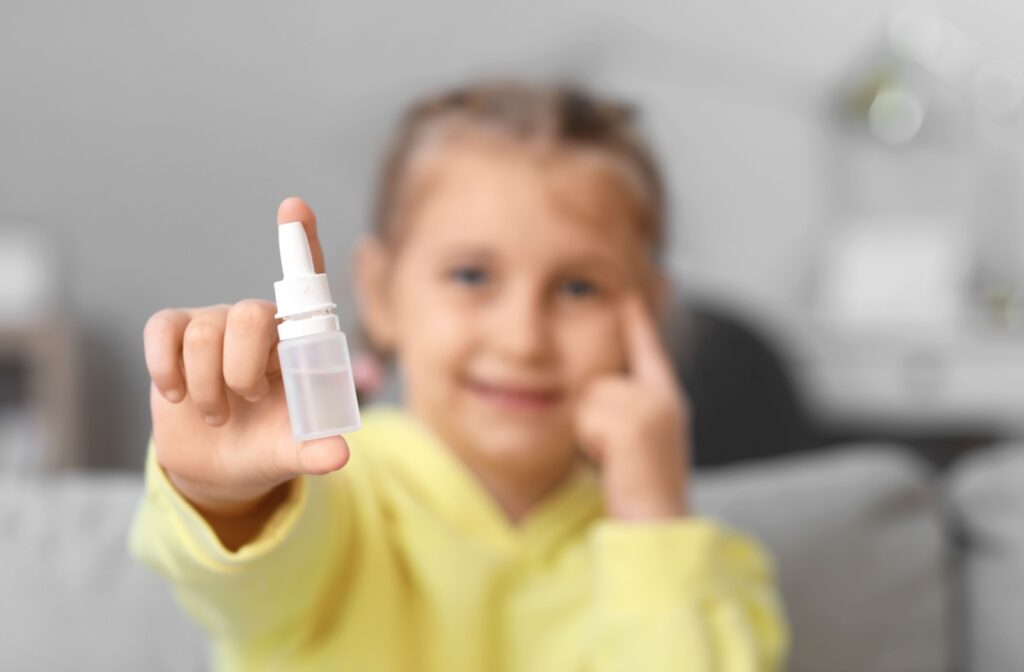Eye drops versatility and convenience, make them a staple in many people’s medicine cabinets and on-the-go bags. They’re applied directly to the eye’s surface, allowing its active ingredient to interact with ocular tissues, letting the treatment quickly take effect.
Children can absolutely benefit from eye drops when used correctly and under the careful guidance of their optometrist. Some common reasons include:
- Dry eyes
- Allergies
- Eye irritation or redness
- Eye infections
- Post-surgery recovery
Eye drops aren’t a one-size-fits-all solution. Knowing when, why, and how to use eye drops can prevent small discomforts from snowballing into bigger concerns.
Are Eye Drops Child Friendly?
Children’s eyes are vulnerable to concerns adults also experience, such as dryness, irritation, and infection, and sometimes undergo eye surgeries to support their vision and eye health. This is why manufacturers create eye drops (over-the-counter and prescription) with children in mind.
However, there are a few things to consider.
Eye drops come in various formulas. Some solutions contain preservatives, steroids, or other chemicals that may discomfort younger eyes.
Even overusing over-the-counter options, like antihistamine drops, can lead to complications, like a rebound effect. It’s a positive feedback loop, where the eyes become redder and more dependent on the drops as time goes on.
The key is discussing suitable options for children’s eyes with your optometrist.
When Can Kids Use Eye Drops?
With proper use, eye drops are a versatile and convenient tool to support eye health for adults and children.
Here are some common cases where children can benefit from the relief eye drops offer.
Dry Eyes
Kids can experience dry eyes for various reasons, such as spending long hours in front of digital screens, spending time in dry or windy environments, or recovering from a cold.
Common dry eye symptoms include:
- Redness
- Burning
- Watery eyes
Artificial tears are great over-the-counter options, offering quick relief by adding moisture to the eyes’ surface.
With varying formulas to choose from, opt for preservative-free options. They’re more gentle on the eyes and minimize the risk of irritation. Children can use preservative-free artificial tears as needed up to 4 times a day.
Allergies
With spring and summer looming just around the corner, seasonal allergies are common among children and can affect their eyes.
Symptoms like watering, itching, redness, and swelling can make outdoor play or focus in the classroom more challenging.
Antihistamine eye drops can help manage these symptoms. With various over-the-counter options, ask your eye doctor for their recommended option, especially if your child has other allergies.
You can use preservative-free artificial tears for further relief, complimenting antihistamine eye drops. As a general rule, you can use antihistamine drops upwards of 4 times a day, but always ask your doctor for further guidance.

Eye Irritations or Redness
Irritations caused by dust, sand, or chlorine from swimming pools are often harmless but very uncomfortable for developing eyes.
Basic lubricating drops, like preservative-free artificial tears, can flush out irritants while soothing and hydrating the eye.
However, if redness persists or worsens, visit your optometrist to rule out an infection or injury from environmental debris. Continuously using eye drops may offer temporary relief, but can mask underlying concerns.
Eye Infections
Pink eye (conjunctivitis) is a well-known eye infection among children and is very contagious, spreading through direct contact.
Children frequently visit high-contact areas like schools, daycares, and after-school programs, increasing their vulnerability to eye infections. They unknowingly rub and touch their eyes without washing their hands, touching surfaces, and spreading bacteria and other pathogens.
Conjunctivitis has many types with bacterial being one of them. Common symptoms of bacterial pink eye include:
- Red or pink eye (hence the name)
- Swelling
- Irritation
- Discharge
An accurate diagnosis confirms the type of pink eye (bacterial, viral, or environmental), the severity of the infection, and proper treatment.
Fortunately, antibiotic eye drops can effectively target and treat the underlying bacterial infection but require a prescription from your eye doctor. Although preservative-free artificial tears can complement antibiotic eye drops, they don’t address the root cause. Without antibiotics, artificial tears only temporarily relieve irritation and can potentially worsen symptoms.
Your eye doctor will determine the appropriate strength, dosage, and duration of antibiotic treatment, tailoring it specifically to your child’s needs.
Post-Surgery Recovery
If your child has undergone eye surgery, such as for strabismus or congenital cataracts, prescription eye drops are a vital part of their recovery process. These drops prevent infection, reduce inflammation, and help the healing process.
Since every case is different, always follow post-operative instructions provided by your child’s eye surgeon or optometrist.
Tips for Safe Use
Introducing eye drops to children can feel tricky. To make the process easier, here are some helpful tips to keep in mind:
- Teach and reassure: Explain why eye drops help keep their eyes and vision healthy and strong. Reassure your child the drops are gentle and will make their eyes feel better.
- Never use expired drops: For safety, check the drop’s expiry date. It’s often printed on the label, marked as “EXP” followed by the month and year.
- Take your time: When administering eye drops, have your child lie down or tilt their head back, focusing on keeping their eyes open. Gently pull down the lower eyelid to create a small pocket where drops can be applied. Encourage blinking to spread the drops evenly.
- Follow dosage instructions: Always stick to the exact dosage and duration prescribed by your child’s doctor, even if symptoms seem to improve before the treatment period is over.
- Watch for side effects: Monitor your child’s response to the eye drops. If you notice redness, irritation, excessive tearing, or other unexpected side effects, contact your optometrist immediately.
Support Healthy Eyes
Your child’s health and well-being are a top priority, and their eye health is no exception. Although eye drops offer several benefits, there’s no alternative for comprehensive, consistent care.
Annual routine eye exams are a proactive way to monitor your child’s vision and eye health. Connect with our White Oaks Optometry team to schedule an appointment for your child’s routine eye exam.



